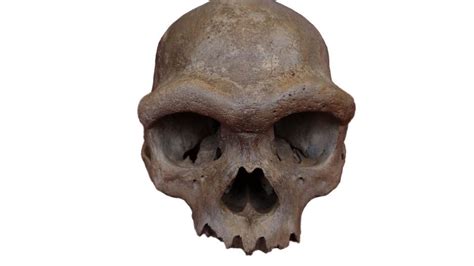
A groundbreaking DNA analysis of the “Dragon Man” skull, a fossil discovered in northeastern China, has revealed a closer genetic relationship to Homo sapiens than Neanderthals, potentially reshaping our understanding of human evolution and suggesting a new lineage in the human family tree.
The analysis challenges previous classifications based solely on the skull’s morphology and places Homo longi, the species name given to Dragon Man, as our closest extinct relative, edging out the Neanderthals. This discovery could rewrite textbooks and challenge long-held assumptions about the trajectory of human development in Asia and its relationship to modern humans. The findings suggest that the lineage leading to Homo longi may have interbred with Homo sapiens, contributing to the genetic diversity of contemporary populations.
The nearly complete cranium, unearthed near Harbin in the Heilongjiang province in the 1930s but only recently brought to scientific attention, exhibits a unique combination of archaic and modern features. Its massive size, large eye sockets, wide mouth, and thick brow ridge distinguish it from other known human species. “The Harbin skull is one of the most complete human cranial fossils ever found,” stated Professor Qiang Ji of Hebei GEO University, a leading researcher in the study. “This fossil preserved many morphological details that are critical for understanding the evolution of the Homo genus and the origin of Homo sapiens.”
The initial morphological analysis in 2021 suggested a new human species, Homo longi, based on the skull’s distinctive characteristics. However, without genetic data, its precise placement in the human evolutionary tree remained uncertain. Now, the DNA evidence, extracted through advanced paleoproteomic techniques, offers compelling support for Homo longi as a distinct lineage closely related to modern humans. The scientists painstakingly reconstructed the ancient DNA from fragmented protein sequences preserved within the skull. This challenging process involved analyzing the degradation patterns of proteins and applying sophisticated computational methods to piece together the genetic information.
The new analysis places Homo longi on a branch of the human family tree that diverged from the lineage leading to Homo sapiens much later than the divergence between Neanderthals and Homo sapiens. Specifically, the estimated divergence time between Homo longi and Homo sapiens is approximately 400,000 years ago, compared to around 600,000 years ago for the Neanderthal-Homo sapiens split. This close relationship suggests a significant evolutionary role for this Asian hominin in shaping the genetic landscape of modern humans.
The researchers believe that Homo longi likely inhabited a vast region of East Asia during the Middle Pleistocene epoch, potentially overlapping with early Homo sapiens populations. This geographical proximity raises the possibility of interbreeding between the two groups, leading to the introgression of Homo longi genes into the Homo sapiens genome. Evidence of such interbreeding could be found in the genomes of modern East Asian populations, although further research is needed to confirm this hypothesis.
The discovery also sheds light on the complex mosaic of human evolution in Asia, which has been historically underrepresented in paleoanthropological studies compared to Africa and Europe. The presence of Homo longi alongside other archaic hominins like the Denisovans suggests a diverse and dynamic evolutionary landscape in Asia, where multiple human lineages coexisted and interacted.
The “Dragon Man” skull itself is remarkably well-preserved, offering a wealth of anatomical information. Its cranial capacity is comparable to that of modern humans, indicating a similar brain size. However, the skull’s robust features, such as the prominent brow ridge and the large, square eye sockets, are characteristic of archaic hominins. The combination of these traits makes Homo longi a unique and intriguing addition to the human family tree.
The circumstances surrounding the skull’s discovery remain somewhat mysterious. It was reportedly found by a construction worker building a bridge over the Songhua River in Harbin during the Japanese occupation of Manchuria. To prevent the skull from falling into the hands of the Japanese, the worker concealed it in an abandoned well, where it remained hidden for decades. The worker, before his death, told his family about the skull, and it was eventually brought to the attention of scientists. This remarkable story adds to the mystique surrounding the “Dragon Man” and its significance in understanding human evolution.
While the DNA analysis provides strong evidence for the close relationship between Homo longi and Homo sapiens, some researchers remain cautious, emphasizing the need for additional fossil evidence and genetic data to solidify the classification. Concerns have been raised about the possibility of contamination or degradation of the ancient DNA, which could affect the accuracy of the results. Moreover, the limited availability of genetic material from other archaic hominins in Asia makes it difficult to fully assess the phylogenetic relationships between Homo longi and other human species.
Nevertheless, the “Dragon Man” discovery represents a major step forward in our understanding of human evolution. It challenges existing paradigms and highlights the complexity and diversity of the human family tree. Future research, including the discovery and analysis of additional Homo longi fossils and the sequencing of more ancient DNA, will undoubtedly provide further insights into the role of this enigmatic hominin in shaping the genetic and cultural landscape of modern humans. This discovery opens up new avenues of investigation into the origins and dispersal of our species and underscores the importance of continued exploration and analysis of the fossil record. The implications of this finding will likely be debated and refined as more evidence emerges, but it undeniably marks a significant contribution to the field of paleoanthropology. The analysis provides compelling evidence that East Asia was a crucial region for human evolution and highlights the need for further research in this area.
The findings also touch upon the ongoing debate regarding species definitions in paleoanthropology. The morphological differences between Homo longi and other hominin species are significant, but the genetic evidence provides a more definitive basis for classifying it as a distinct lineage. The convergence of morphological and genetic data strengthens the case for Homo longi as a new human species, but the debate over its precise taxonomic status is likely to continue.
The implications extend to understanding human adaptation and dispersal. The environment in which Homo longi lived was likely cold and harsh, similar to that of Neanderthals in Europe. This suggests that Homo longi may have possessed adaptations to cold climates, such as a robust build and specialized tools for hunting and survival. Studying these adaptations could provide valuable insights into how humans evolved to thrive in different environments.
Furthermore, the “Dragon Man” discovery has sparked renewed interest in the search for other archaic hominin fossils in Asia. The vast and largely unexplored regions of China, Siberia, and Southeast Asia hold immense potential for uncovering new evidence of human evolution. Future expeditions and archaeological excavations could reveal additional species and shed light on the complex interactions between different human lineages in Asia.
The study of ancient DNA, known as paleogenomics, has revolutionized our understanding of human evolution. The ability to extract and analyze genetic material from fossils has provided unprecedented insights into the relationships between different human species and the genetic makeup of our ancestors. However, paleogenomics is a challenging field, requiring sophisticated techniques and careful attention to detail. The degradation of DNA over time and the risk of contamination pose significant obstacles to obtaining accurate and reliable results.
The success of the “Dragon Man” DNA analysis demonstrates the power of advanced paleoproteomic techniques in overcoming these challenges. By focusing on proteins, which are more stable than DNA, researchers were able to reconstruct the genetic information of Homo longi. This breakthrough opens up new possibilities for studying the genetic history of other archaic hominins, even in cases where DNA is severely degraded.
The discovery of Homo longi also raises ethical considerations regarding the treatment and preservation of human fossils. The “Dragon Man” skull was hidden for decades before being brought to the attention of scientists. This highlights the importance of public awareness and education in promoting the responsible handling of fossil discoveries. Museums and research institutions have a crucial role to play in ensuring that these valuable resources are preserved and studied for the benefit of humanity.
The story of the “Dragon Man” is a testament to the power of scientific curiosity and the enduring quest to understand our origins. It underscores the importance of interdisciplinary collaboration, bringing together experts in paleontology, genetics, archaeology, and other fields to unravel the mysteries of human evolution. As we continue to explore the fossil record and refine our understanding of the human family tree, we gain a deeper appreciation for the complexity and diversity of our species and the long and winding road that has led to our present-day existence.
The ongoing research into Homo longi promises to yield further insights into its biology, behavior, and relationship to other human species. Future studies will focus on analyzing the skull’s internal structure using advanced imaging techniques, reconstructing the facial features of Homo longi, and comparing its skeletal anatomy to that of other hominins. These efforts will contribute to a more complete picture of this enigmatic human species and its place in the human evolutionary story.
The discovery further emphasizes that the story of human evolution is far more intricate than previously thought. It challenges the linear progression models and suggests that multiple human lineages coexisted, interacted, and potentially interbred, creating a complex web of relationships that shaped the genetic and cultural landscape of our species.
Frequently Asked Questions (FAQ)
1. Who is “Dragon Man” (Homo longi) and why is this discovery significant?
“Dragon Man,” scientifically known as Homo longi, is a newly identified archaic human species discovered in northeastern China. The significance of this discovery lies in the recent DNA analysis indicating that Homo longi is potentially a closer relative to Homo sapiens (modern humans) than Neanderthals, challenging existing understandings of human evolutionary relationships and suggesting a new, previously unknown lineage in the human family tree. It has the potential to rewrite textbooks and challenge long-held assumptions about the trajectory of human development in Asia and its relationship to modern humans.
2. How did scientists determine the genetic relationship of “Dragon Man” without traditional DNA?
Given the age of the skull and the degradation of its DNA, scientists employed advanced paleoproteomic techniques. This involved extracting and analyzing proteins from the skull, which are more stable than DNA over long periods. By studying the amino acid sequences of these proteins, they were able to reconstruct a significant portion of the ancient genome. Through complex computational methods, scientists compared the genetic information of Homo longi to that of Neanderthals and Homo sapiens, determining its phylogenetic position.
3. Where and when was the “Dragon Man” skull found, and what are its distinguishing features?
The skull was discovered in the 1930s near Harbin in the Heilongjiang province of northeastern China but was only recently brought to scientific attention. It was reportedly found by a construction worker building a bridge over the Songhua River. The skull is distinguished by its massive size, large eye sockets, wide mouth, thick brow ridge, and cranial capacity similar to that of modern humans. These features represent a unique combination of archaic and modern traits.
4. What are the implications of the “Dragon Man” discovery for our understanding of human evolution in Asia?
The “Dragon Man” discovery highlights the importance of Asia as a key region for human evolution. The existence of Homo longi alongside other archaic hominins like the Denisovans suggests a diverse and dynamic evolutionary landscape in Asia, where multiple human lineages coexisted and interacted. This challenges the Eurocentric view of human evolution and underscores the need for further research in Asia to fully understand the origins and dispersal of our species. It potentially reshapes our understanding of human evolution and suggests a new lineage in the human family tree.
5. Could “Dragon Man” have interbred with Homo sapiens, and what evidence supports this hypothesis?
Given the geographical proximity and estimated divergence time between Homo longi and Homo sapiens, researchers suggest that interbreeding between the two groups is plausible. Evidence of such interbreeding could be found in the genomes of modern East Asian populations, potentially explaining some of the genetic diversity observed in these populations. Future research, including the analysis of more ancient DNA and the study of modern human genomes, is needed to confirm this hypothesis. The potential for interbreeding contributes to the complexity and richness of human genetic history.









